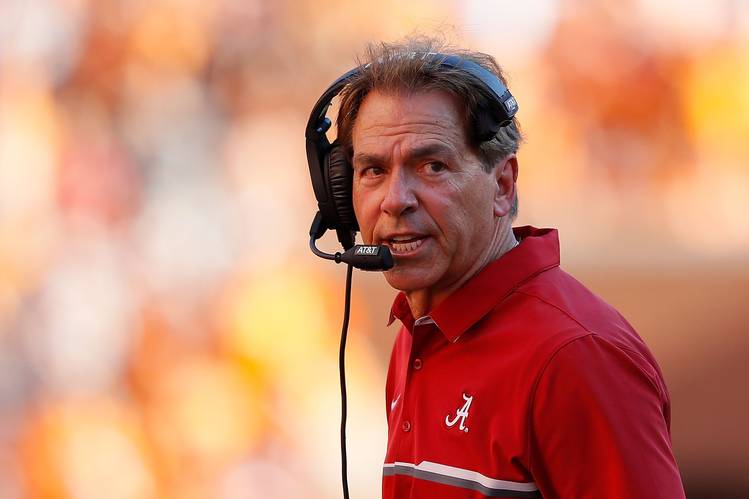From the Wall Street Journal:
The first Wednesday of February has become an annual holiday where people manically obsess over where a bunch of teenagers will go to college. It’s known as National Signing Day, and it’s the first time high school seniors can officially sign with schools to play football.
But as fans wonder if this year’s batch of recruits will lead their team to a title, two researchers looked for an answer to a slightly different question: How much are these recruits actually worth?
The best ones may be worth $465,000 annually, according to an analysis by Trevon Logan, an economics professor at Ohio State, and Stephen Bergman. In their paper, which was published in the Journal of Sports Economics last year, they examined how success at every school changed as the caliber of their recruits at that school differed over time. Then they could answer how much more money a school could stand to make when it signs better players.

Head coach Nick Saban of the Alabama Crimson Tide is expected to recruit the most prized in-coming class for 2017. Photo: Kevin C. Cox/Getty Images
“The hype around signing day can be overblown at times,” Bergman said, “but financially these recruits have significant effects on the programs.”
That $465,000 value of five-star recruits—players regarded as the best high-school prospects—is more than double that of four-star players, they found, at $181,000. Three-star players averaged $60,000 in value while two-star ones netted a loss of $75,000. Basically, a team that depended on two-star rated players would expect to lose money.
These values stem not only from the balance sheets of the football programs, which can receive major windfall by reaching high-profile bowl games, but also from the success of each school’s conference. That’s because schools stand to gain from the success of their league: An elite player that goes to Michigan may help the Wolverines beat Ohio State, but the Buckeyes may benefit too because portions of conference revenue are shared.
In the College Football Playoff era, this may be even more true, Logan added. Unlike the computerized system of the bygone Bowl Championship Series, the selection committee relies in part on an eye-ball test to evaluate teams, so stronger players at a rival school could fuel the perception that your team’s performance was better and deserves to get in. That would add even more to how much the best players help net their schools.
“If we’re going to pay student athletes, it can’t be the case that you would pay all of them the same,” Logan said.
The first Wednesday of February has become an annual holiday where people manically obsess over where a bunch of teenagers will go to college. It’s known as National Signing Day, and it’s the first time high school seniors can officially sign with schools to play football.
But as fans wonder if this year’s batch of recruits will lead their team to a title, two researchers looked for an answer to a slightly different question: How much are these recruits actually worth?
The best ones may be worth $465,000 annually, according to an analysis by Trevon Logan, an economics professor at Ohio State, and Stephen Bergman. In their paper, which was published in the Journal of Sports Economics last year, they examined how success at every school changed as the caliber of their recruits at that school differed over time. Then they could answer how much more money a school could stand to make when it signs better players.

Head coach Nick Saban of the Alabama Crimson Tide is expected to recruit the most prized in-coming class for 2017. Photo: Kevin C. Cox/Getty Images
“The hype around signing day can be overblown at times,” Bergman said, “but financially these recruits have significant effects on the programs.”
That $465,000 value of five-star recruits—players regarded as the best high-school prospects—is more than double that of four-star players, they found, at $181,000. Three-star players averaged $60,000 in value while two-star ones netted a loss of $75,000. Basically, a team that depended on two-star rated players would expect to lose money.
These values stem not only from the balance sheets of the football programs, which can receive major windfall by reaching high-profile bowl games, but also from the success of each school’s conference. That’s because schools stand to gain from the success of their league: An elite player that goes to Michigan may help the Wolverines beat Ohio State, but the Buckeyes may benefit too because portions of conference revenue are shared.
In the College Football Playoff era, this may be even more true, Logan added. Unlike the computerized system of the bygone Bowl Championship Series, the selection committee relies in part on an eye-ball test to evaluate teams, so stronger players at a rival school could fuel the perception that your team’s performance was better and deserves to get in. That would add even more to how much the best players help net their schools.
“If we’re going to pay student athletes, it can’t be the case that you would pay all of them the same,” Logan said.